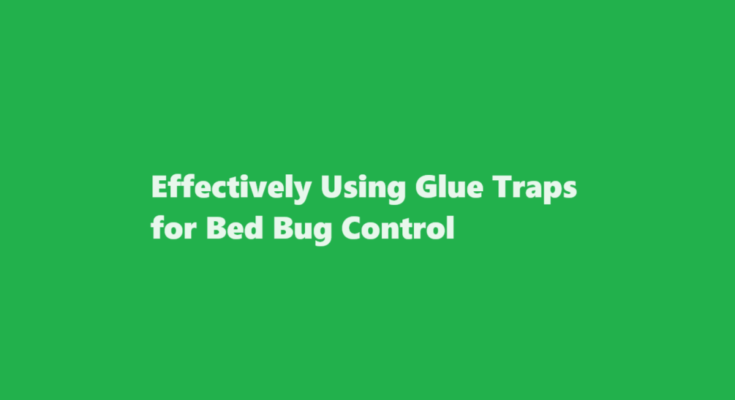Introduction
Bed bugs, those nocturnal nuisances that invade our homes and disrupt our sleep, have been a persistent problem for centuries. If you’ve experienced a bed bug infestation, you understand the frustration and discomfort it can cause. While there are various methods for combating these pests, one useful tool in your arsenal is the glue trap. In this article, we’ll discuss how to use glue traps effectively to help eradicate bed bugs and regain peace of mind.
Understanding Bed Bugs
Before delving into the use of glue traps, it’s crucial to understand the enemy you’re dealing with. Bed bugs, scientifically known as Cimex lectularius, are small, reddish-brown insects that feed on the blood of humans and animals. They are notoriously skilled at hiding in cracks, crevices, and other tiny spaces near their feeding sources, making them challenging to eliminate.
The Benefits of Glue Traps
Glue traps are an excellent choice for bed bug control for several reasons
1. Non-Toxic: Glue traps are non-toxic and do not involve the use of harmful chemicals or pesticides. This makes them a safer option for households with children, pets, or individuals with sensitivities to chemicals.
2. Cost-Effective: Compared to professional pest control services, glue traps are an affordable solution for homeowners on a budget. They are readily available at most hardware stores and online retailers.
3. Easy to Use: Using glue traps doesn’t require special training or equipment. They are simple to set up and can be strategically placed in various locations where bed bugs are suspected.
4. Monitoring: Glue traps are an effective monitoring tool, helping you assess the extent of your bed bug infestation. Regularly inspecting the traps allows you to track the infestation’s progress.
Using Glue Traps Effectively
Now, let’s explore how to use glue traps effectively to combat bed bugs
1. Identify Infested Areas: Before placing glue traps, identify areas where bed bugs are likely to congregate. These may include your mattress seams, box spring, bed frame, headboard, and nearby furniture.
2. Clean and Declutter: Tidy up your bedroom and remove any clutter that could provide hiding spots for bed bugs. Launder your bedding, curtains, and clothing in hot water and dry them on the hottest setting to kill any hidden bed bugs.
3. Place the Traps Strategically: Once you’ve cleaned and decluttered, strategically place the glue traps in areas where bed bugs are likely to travel. This could include the perimeter of your mattress, under the mattress, and along the baseboards. You can also put traps near the legs of your bed and other furniture.
4. Ensure Proper Adhesion: Make sure that the glue traps are securely in place. Ensure they are flat on the surface and won’t be easily disturbed by movement. The adhesive surface should be exposed and ready to catch any wandering bed bugs.
5. Check Traps Regularly: To monitor the effectiveness of the traps, check them regularly, ideally every few days. If bed bugs are caught on the trap, dispose of it properly and replace it with a fresh one.
6. Record and Document: Maintain a record of the number of bed bugs caught on each trap. This documentation will help you gauge the infestation’s severity and track your progress.
7. Supplement with Other Methods: While glue traps are a valuable tool, they are most effective when used in conjunction with other bed bug control methods, such as vacuuming, steam cleaning, and encasing your mattress and box spring in bed bug-proof covers.
8. Seek Professional Help If Necessary: If your bed bug infestation is extensive or persistent, consider consulting a pest control professional. They have access to more powerful treatments and can provide guidance on effective strategies for your specific situation.
Precautions and Safety
While glue traps are safe to use, there are some precautions to keep in mind
1. Keep Glue Traps Away from Children and Pets: Place glue traps in areas inaccessible to children and pets to prevent accidental contact.
2. Handle Traps Carefully: When disposing of used glue traps, handle them with caution to avoid touching the adhesive surface. Use gloves if necessary, and place the traps in a sealed plastic bag before throwing them away.
3. Store Traps Properly: Keep unused glue traps in their original packaging and store them in a cool, dry place away from direct sunlight.
FREQUENTLY ASKED QUESTIONS
Do glue traps help with bed bugs?
Using glue traps is another way to capture bed bugs and detect a possible infestation in your home. Glue traps are disposable and ready-to-use contraptions containing sticky glue that bed bugs (and other insects) can’t escape from.
What liquid attracts bed bugs?
The trap becomes even more effective when it is baited with a cocktail consisting of nonanal and 1-octen-3-ol (two substances found in human body odour), spearmint oil, and coriander Egyptian oil. As in a previous experiment, the team found that these four chemicals are good at attracting bedbugs.
Conclusion
Using glue traps for bed bug control is an effective and cost-efficient method for dealing with these pesky pests. By strategically placing the traps in infested areas, monitoring their effectiveness, and supplementing with other bed bug control methods, you can significantly reduce the bed bug population in your home. Remember that patience and persistence are key when dealing with bed bugs, and seeking professional help may be necessary in severe cases. With diligence and the right tools, you can regain a good night’s sleep and peace of mind.
Read Also : A Step-by-Step Guide to Changing Your Birthday on TikTok



